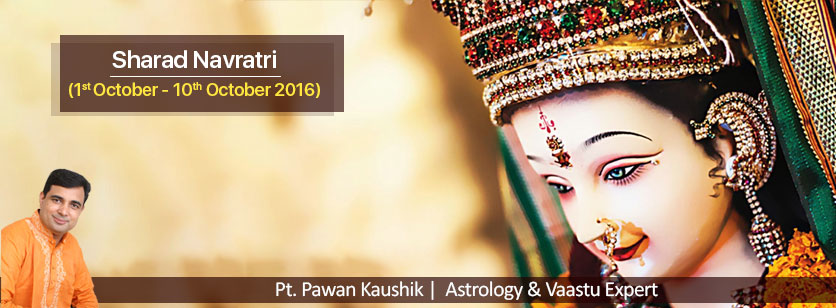
Navratri is a Sanskrit word, which interprets nine nights (‘nav’ and ‘ratri’). These nine days are devoted to Hindu Goddess Durga who represents the power, or shakti. Following the Lunar calendar, this festival is celebrated in March and April as Chaitra Navrati (onset of Spring); and in September and October as Sharad Navrati (onset of autumn).
A famous Astrologer in Gurgaon, Pt. Pawan Kaushik says, “Rigveda has described the shakti in its tenth mandal of Devi Sukhta and Isha Sukhta. The Samaved has Ratri Sukta that praises the shakti. Goddess Durga, the shakti was also worshipped by Lord Krishna at the time of war between the Kaurava and Pandavas, for the victory of Panvadas”. Each of these 9 days of Navratri is dedicated to different incarnations (roop) of shakti. Besides this, on each of these 9 days of Navratri, women follow the ritual of wearing respective colours of dress:
First day – Shailputri
This form of Goddess incorporates the power of Lord Brahma, Lord Vishnu and Lord Mahesh; and is worshipped as wife of Lord Shiva. Dressed in Grey, Shailputri maa symbolizes power and strength. Color for the day: Red.Second day- Bhramcharini
This form of Goddess Durga notifies us about the splendid incarnation of Durga that has immense ability and divine. Worshipping this form of Durga on this day leads a person to moksha. The color of the day is Royal blue which instills the worshipper with peace and strength. Color for the day: Royal Blue.Third day- Chandraghanta
This roop of shakti symbolizes bravery and strength to fight against the wrongs. Worshipping Her on this day can bless the worshipper with immsense prosperity and peace. The color of this day is yellow which represents the power and grace from Her divine blessings. Color for the day: Yellow.Fourth day- Kushmunda
This roop of Durga is considered to be the creator of this entire universe. She is believed to bloom the vegetations and personifies the light. The color associated with this day is green. Color for the day: Green.Fifth day- Sakand Mata
This form of Durga is the mother of Lord Karthikeya, the commander in chief of Devas who waged a war against demons. Sakand mata represents the unconditional love that a mother has for her child, for whom she can fight the storm to protect her child from any negativities. Color for the day: Grey.Seventh day- Kalratri
As the name suggest, this form of Durga has dark complexion and unkempt hair. She is dressed in white and protects the devotees from all sorts of harms and troubles. Color for the day: White.Eighth day- Maha Gauri
This form of Durga is tranquil and calm. After long austerities in dense forest of Himalayas, her color changed into black. But when Lord Shiva washed her body with sacred water of River Ganga, she regained her beauty and turned into Maha Gauri. The color of this day is pink which symbolizes the hope for a new start. Color for the day: Pink.Ninth day- Siddhidatri
As the name says, all the pending work and desires can be fulfilled by worshipping this divine form of Goddess Durga. She is seen with four hands in a blissful pose. All the worries and negativities of the worshipper can vanish on worshipping this form of Durga. Color for the day: Sky blue.THE SYMBOLISM OF 8 ARMS OF GODDESS DURGA
Maa Durga is often depicted as sitting on a lion or a tiger. As a lion is known for it’s arrogance and ego, this represents her power to control the ego. The idol of Goddess Durga is also depicted with represent three eyes: the first eye symbolizes the desire; the second eye symbolizes the action; and the central eye represents the knowledge. Besides this, She is also depicted with eight arms, which symbolizes her protection towards her devotees from all directions:
- First Hand : The upper first right hand often holds the Chakra. This Chakra is the symbol of responsibilities and duties (dharma).
- Second Hand : The upper first left hand holds the Conchshell (Shankh). This represents the need of performing the duties, whole-heartedly with happiness.
- Third Hand : The second right lower hand holds the sword. This represents the need to learn to distinguish between good and bad; and the need to eliminate the evil inside us.
- Fourth Hand : The second left lower hand holds the bow and arrow, similar to the idol of Lord Rama. This communicates that even in tough times, one should never lose his morals.
- Fifth Hand : The third lower left hand holds the Lotus flower. A Lotus flower is known for its beauty, no matter how muddy/dirty it’s environment is. This represents the need for detachment from the outer world and from the greed and lust.
- Sixth Hand : The third right lower hand holds the club (gada), similar to the idol of Lord Hanuman. This represents the need for dedication and surrender for whatever we desire and the need to whole-heartedly accept the consequence as per the Almighty’s will.
- Seventh Hand : The fourth left lower hand holds the Trident (Trishul). This represents bravery and the courage required to face the hurdles and difficulties of life.
- Eighth Hand : The fourth Lower Right Hand represents the need to forgive oneself and other people for the mistakes and sufferings one may have caused.
It is believed that all the women are blessed with all forms of Goddess Durga; and for this very reason, girls are fed with food and given gifts on the completion of all 9 days of Navratri.
 +91 9990176000
+91 9990176000 +91 9999097600
+91 9999097600
 CALENDAR 2024
CALENDAR 2024










